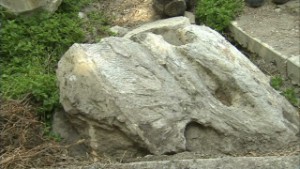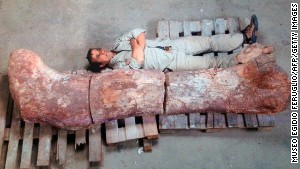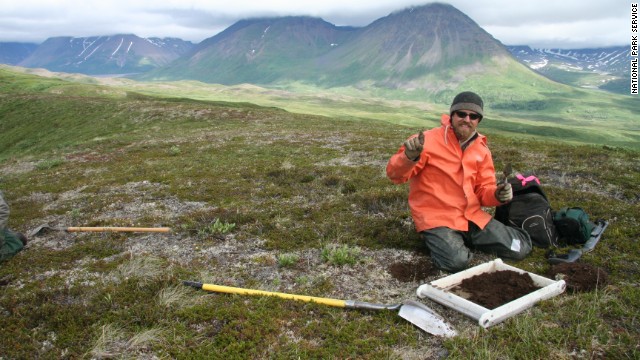8 places for fantastic fossil finds8地方太棒了化石的發現
- There have been dinosaur finds across the United States this summer
- One recently unearthed stegomastodon fossil is 3 million years old
- Some spots allow visitors to keep the fossils they find
(CNN) -- A bird with an estimated 20- to 24-foot wingspan wasidentified in South Carolina. There's evidence that dinosaurs roamed what's now a national park in Alaska, and a 9-foot-tall stegomastodon was unearthed in New Mexico.
And those are just the fossil finds made across the United States this summer. If you're fascinated by magnificent prehistoric creatures, there's plenty more exploration to be done.



No need to worry about a Jurassic Park attack.
These eight "fossil finds" offer unique family-friendly, T.-Rex-free ways for paleontologists of all ages to explore prehistoric life. So pack up your family and start uncovering some of the planet's most fascinating previous inhabitants.
Denali National Park, Alaska
Just this month, as tracks of large, plant-eating dinosaur herds were discovered in Alaska's Denali National Park, scientists gained a new picture of prehistoric Arctic wildlife.
The tracks ranged from 5 to 24 inches and came from hadrosaurs -- plant-eating, duck-billed dinosaurs. Hadrosaurs were prevalent during the late Cretaceous period nearly 70 million years ago, and the new tracks only add to Alaska's rich dinosaur history.
"We discovered the first dinosaur tracks in 2005, and now since we know what to look for, we've since discovered thousands of tracks," said Denali park ranger Kris Fister.
"Here, these tracks are unique because it houses traces of the entire ecosystem," she said. "Birds, insects and plant life -- it really paints a picture of what life was in the area."
The tracks are not accessible through guided hikes or paved trails, but experienced hikers can find them nestled in Denali's back country, Fister said.
Agate Fossil Beds National Monument, Nebraska
What exactly is a beardog? Take a tour through the Agate Fossil Beds National Monument in Nebraska, where 20 million years ago the land now known as the Agate was a grassy plain comparable to Africa's Serengeti.
At Agate, roaming animals once included the beardog (Amphicyon), a 6-foot-long hunting creature that actually is not related to the bear or the dog.
There's also evidence of the dinohyus (large pig-like animal) and a short rhinoceros called a Menoceras.
As rock weathered and terrain shifted, these species died off and became fossilized, and they are now visible in the Agate cliffs.
Montour Fossil Pit, Pennsylvania
Stake your claim at the Montour Preserve and fossil pit, an excavation site about 230 miles northeast of Pittsburgh where visitors can dig for fossils.
Montour's marine fossils date to the Devonian Period, about 400 million years ago. And even more fun: All collected artifacts are yours to keep.
Fossils include trilobites (relatives of horseshoe crabs with segmented bodies and frog-like eyes), pelecypods (early ancestors of oysters, mussels and clams) and gastropods (snails).
One tip: Wait until after a good rain shower to go fossil hunting. Sometimes the rain can make the fossils easier to spot in the rock.
Dinosaur National Monument, Utah
The Quarry Exhibit Hall is the unquestioned star of Dinosaur National Monument's show. About 1,500 dinosaur bones from up to 149 million years ago and an 80-foot mural reveal the history of the dinosaurs and their eventual demise.
Bone displays include meat-eating reptiles like the 20-foot long Allosaurus and massive, grass-eating dinos like the Camarasaurus, Diplodocus and Stegosaurus.
Outside the exhibit hall, this monument to dinosaurs still has a rich variety of wildlife throughout the area. Adventurous visitors can take a whitewater rafting trip through remote canyon areas.
Hell Creek Beds, Montana
Hell Creek is a fossil lover's heaven.
Expansive and well-preserved, the rock bed formation spans four states -- Montana, North Dakota, South Dakota and Wyoming -- although the main park is squarely in Montana.
Fossils date to the late Cretaceous period, 65 million to 70 million years ago, and were discovered in 1902 by paleontologist Barnum Brown.
Today, families can take guided, private day digging tours with experienced paleontologists to hunt fossils. And in Hell Creek, abundant species include the distinctively horned ceratopsians; the duck-billed herbivore creatures called hadrosaurs; and theropods, the lizard-like carnivorous dinosaurs.
But there's another reason historians love the Hell Creek beds: The chemical presence of iridium in some rocks gives credence to the theory of a dinosaur extinction caused by a meteor.
Ghost Ranch, New Mexico
Play Ghost (Ranch) buster at this spot's Museum of Paleontology. This New Mexican museum includes bones of the coelophysis, a slender, two-legged carnivore that was over 9 feet long and grazed the ranch's grassy plains nearly 220 million years ago.
Other dinosaurs on display include the 6-foot-long therapod Tawa hallae and Vancleavea, an underwater reptile.
After a tour of the museum, venture into the Coelophysis Quarry, where red beds of rock have preserved the remains of at least 1,000 rare species.
Red Gulch Dinosaur Tracksite, Wyoming
With walkways and set excavation areas, Red Gulch Dinosaur Tracksite in Wyoming is the perfect site for an introduction to paleontology and dino-digging.
Plus, the track site, named for being an area where footprints and fossils are preserved, includes managers of the excavation sites to help beginning visitors identify dinosaur tracks in the sand.
Fossil collection is permitted on most days, barring road closures and fire danger, and the rewards for a fossil hunt are great.
Trilobites, brachiopods (shell creatures) and all invertebrate fossils can be collected for personal use and without permit. And some of those fossils date 167 million years.
However, if you want to search like a professional paleontologist for vertebrate fossils -- with bones and teeth -- a permit is required.
La Brea Tar Pits at the Page Museum, California
They call it Excavation 101. And it begins with a fossil deposit, a grid and the careful removal of dirt to find a bone.
Part of the Page Museum in Los Angeles, the La Brea Tar Pits' outside pits and the museum's inside exhibits create a must-see attraction for West Coast fossil lovers.
There are outside options where viewers can observe excavations of California's rich wildlife, explore prehistoric fossils and learn the basics of excavation.
At the Page Museum, visitors look at expansive fossil exhibits, including full replicas of the smilodon, an extinct saber-toothed cat. The museum's Fossil Lab allows visitors to peer though the glass walls to watch fossils get cleaned, enhanced and prepared for viewing.
8地方太棒了化石的發現
通過Astead赫恩登,特向美國有線新聞網
2014年8月8日 - 更新1829 GMT(0229 HKT)
迪納利國家公園在阿拉斯加是最近發現的部位:從鴨嘴龍類,植物為食的恐龍出沒近70萬年前追踪。 迪納利國家公園在阿拉斯加是最近發現的部位:從鴨嘴龍類,植物為食的恐龍出沒近70萬年前追踪。
隱藏字幕
狩獵恐龍時代的痕跡
<<
<
1 2 3 4 5 6 7 8
>
>>
新聞提要
曾有恐龍發現在美國這個夏天
一個最近出土stegomastodon化石是300萬年的老
一些景點讓遊客以保持他們發現這些化石
(CNN) -估計有20到24英尺的翼展一隻鳥被認定在南卡羅來納州。有證據表明,恐龍出沒什麼,現在在阿拉斯加國家公園和一個9英尺高的stegomastodon是出土於新墨西哥州。
而這些僅僅是的化石在美國取得了今年夏天。如果你被宏偉的史前生物迷住了,有足夠多的探索工作要做。
罕見的鯨魚化石回收 新發現的化石是有史以來最大的 你如何移動恐龍化石的一群?
無需擔心侏羅紀公園的攻擊。
這八個“的化石”提供了獨特的家庭友好型,T-REX-免費的方式為各年齡段的古生物學家發掘史前生活。所以,收拾你的家人,並開始揭露一些地球上最迷人的前一個居民。
迪納利國家公園,阿拉斯加
就在這個月,作為大,植食性恐龍成群的軌道被發現在阿拉斯加的德納裡峰國家公園,科學家們獲得了史前北極野生動物的新圖景。
曲目從5到24英寸不等,他們來自鴨嘴龍 - 以植物為食,鴨嘴龍。鴨嘴龍類近7000萬年前在白堊紀晚期盛行,而新的軌道只會增加阿拉斯加豐富的恐龍歷史。
“我們在2005年發現的第一個恐龍足跡,現在既然知道要尋找什麼,我們既然發現了成千上萬的曲目已經”迪納利公園護林員克里斯菲斯特說。
“說到這裡,這些曲目都是獨一無二的,因為它的房子整個生態系統的痕跡,”她說。“鳥類,昆蟲和植物的生命 - 它確實描繪了什麼樣的生活是在該地區的照片。”
軌道不通過導遊的遠足或鋪設步道訪問,但有經驗的徒步旅行者可以找到他們在德納裡峰背上的國家依偎,菲斯特說。
瑪瑙化石床國家紀念碑,內布拉斯加
到底是什麼beardog?採取參觀過瑪瑙化石床國家紀念碑在內布拉斯加州,在那裡2000萬年以前的土地現在被稱為瑪瑙是草地堪比非洲的塞倫蓋蒂。
在瑪瑙,漫遊的動物,一旦列入beardog(Amphicyon),實際上是不相關的熊或狗的6英尺長的狩獵動物。
另外還有dinohyus(大豬一樣的動物)和短犀牛稱為Menoceras的證據。
由於岩石風化和地形移位,這些物種離開了人世,成為化石,而他們現在的瑪瑙懸崖可見。
Montour化石坑,賓夕法尼亞
堅持你的Montour保存和化石坑的發掘現場約230英里匹茲堡東北的遊客在這裡可以挖掘化石。
Montour的海洋生物化石日期為泥盆紀,約400萬年前。甚至更多的樂趣:收集的所有文物是你保持。
化石包括三葉蟲(馬蹄蟹與分段機構和青蛙一樣的眼睛的親屬),pelecypods和腹足類(蝸牛)(牡蠣,貽貝和蛤的早期祖先)。
給你一個建議:等到一個好花灑淋浴去化石狩獵。有時下雨可以使化石更容易在岩石被發現。
恐龍國家紀念公園,猶他
該石礦場展廳是恐龍國家紀念公園的表演毫無疑問的明星。從高達149萬年前約1500恐龍骨骼和一個80英尺的壁畫揭示了恐龍的歷史,其最終的滅亡。
骨顯示器包括食肉爬行動物,如20英尺長的異特龍和大規模,食草恐龍如圓頂龍,梁龍和劍龍。
外面的展廳,這個紀念碑的恐龍仍然有豐富多樣的野生動物的整個地區。喜歡冒險的遊客可以通過遠程峽谷領域泛舟之旅。
地獄溪床上,蒙大拿
地獄溪是化石愛好者的天堂。
膨脹和保存完好的岩層形成橫跨四個州 - 蒙大拿州,北達科他州,南達科他州和懷俄明州 - 雖然主要公園是正視在蒙大拿州。
化石約會到晚白堊世時期,6500萬至70萬年前,並發現 了古生物學家巴納姆·布朗於1902年。
如今,家庭可以參加有導遊,私人挖一天遊經驗豐富的古生物學家狩獵化石。而在地獄溪,豐富的物種,包括獨特角角龍; 鴨子嘴草食性的動物稱為鴨嘴龍類; 和獸腳類恐龍,蜥蜴般的食肉恐龍。
但還有另一個原因,歷史學家喜歡的地獄溪床:銥的一些岩石的化學存在給予信任造成的流星恐龍滅絕的理論。
幽靈牧場,新墨西哥
玩鬼(牧場)的剋星,在這個地方的古生物博物館。這家墨西哥的博物館包括腔骨龍,修長,兩足食肉動物,這是超過9英尺長,近2.2萬年前放牧牧場的草地平原的骸骨。
其他恐龍的展出,包括6英尺長的therapod塔瓦hallae和Vancleavea,水下爬行動物。
博物館的參觀後,冒險進入腔骨龍石礦場,那裡的岩石紅層都保留至少1000珍稀物種的遺骸。
紅峽谷恐龍Tracksite,懷俄明
與人行道,並設置開挖區,紅峽谷恐龍Tracksite在懷俄明州是一個完美的網站的介紹,古生物學和恐龍挖。
此外,在 軌道站點,命名為是這裡的足印化石被保存的區域,包括開挖網站管理人員,以幫助遊客開始確定在沙灘上的恐龍腳印。
化石收藏是允許的大部分時間,除非封路和火災的危險,並為化石狩獵的回報是巨大的。
三葉蟲,腕足類(殼生物)和所有脊椎動物化石可以收集個人使用,沒有許可證。而其中的一些化石之日起1.67億年。
但是,如果你要搜索像一個專業的古生物學家的脊椎動物化石 - 與骨骼和牙齒 - 許可證是必需的。
拉布雷亞瀝青坑頁面博物館,加州
他們稱之為開挖101它始於化石存款,網格和細心去除污垢找到一根骨頭。
在部分頁面博物館在洛杉磯拉布雷亞瀝青坑“坑外和館內的展品裡面創建一個必須看到的吸引力西海岸化石愛好者。
有外部選擇在那裡,觀眾可以看到加州豐富的野生動物的發掘,發掘的史前化石,發掘學習的基礎知識。
在頁面博物館,參觀者看到廣闊的化石展品,其中包括劍齒虎,一種已滅絕的劍齒貓完整副本。博物館的化石實驗室,讓遊客同行,雖然玻璃牆觀看化石得到清理,加強和觀看準備。
 Denali National Park in Alaska is the site of a recent find: tracks from hadrosaurs, plant-eating dinosaurs that roamed nearly 70 million years ago.
Denali National Park in Alaska is the site of a recent find: tracks from hadrosaurs, plant-eating dinosaurs that roamed nearly 70 million years ago.


 留言列表
留言列表
 {{ article.title }}
{{ article.title }}

